I arrived by Virgin 'Pendolino' at Euston and walked along Euston Road to Euston Square station where I caught a train five stops on the historic Circle Line to Liverpool Street.
Liverpool Street - Stratford
I didn't pause to admire the restored parts of the Great Eastern Railway terminus around the main line concourse but made my way to the subterranean platforms to catch a Stratford train.
I was surprised to find that the service between Liverpool Street and Shenfield had, since May 2015, been operated for TfL Rail by MTR Corporation (Crossrail) Limited (who, following the previously-noted fear of capital letters which is becoming endemic, usually call themselves 'mtr crossrail'). When the massive Crossrail Project is complete, MTR will also operate the new or upgraded route from Reading and Heathrow in the west to Shenfield and Abbey Wood in the east, under the branding 'Elizabeth Line'. The line will be operated by new, 9-coach Class 345 'Aventra' trains being built by Bombardier in Derby.
At the time of my visit, Class 315 EMU were operating the service from Liverpool Street, terminating at Brentwood, presumably whilst upgrading was taking place on the rest of the line to Shenfield.
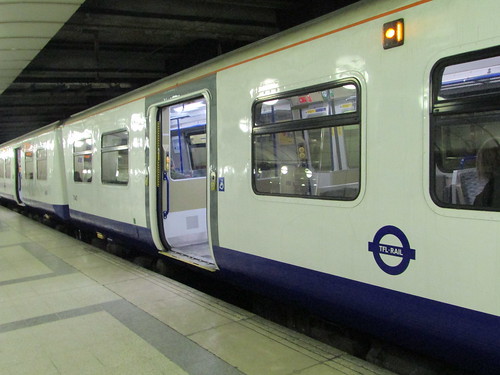
Class 315, in TfL Rail livery, in platform 17 at Liverpool Street.
We departed on time and effortlessly climbed the bank to Bethnal Green, where the branches to north London diverge, and continued to Stratford, passing the once-notorious former Bryant & May match factory, which is now apartments in the 'Bow Quarter', with a website here. I say 'once-notorious' as this was the location for the "Match Girls' Strike" of 1888 which led to the creation of the first womens' trade union.
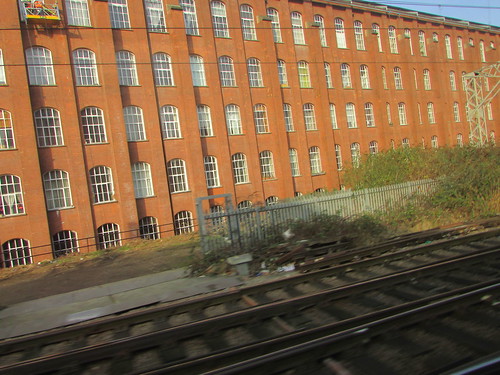
The former Bryant & May match factory, now apartments in the 'Bow Quarter'.
After passing the Queen Elizabeth Olympic Park (with its dreadful ArcelorMittal Orbit tower - more on their website here), we slowed for the station stop at Stratford, where I left the train.

Queen Elizabeth Olympic Park, home to West Ham United Football Club and the ArcelorMittal Orbit.
Docklands Light Railway
I had not kept up with the pace of developments on the Docklands Light Railway (DLR). There's an informative history of the network, including proposals for still further extension, in Wikipedia here and the present route map is here.
The system originally opened, in 1987, with a just a city terminus rather inconveniently located at Tower Gateway extending via Canary Wharf to a terminus at Island Gardens, north of the river. At Poplar, just north of Canary Wharf, a triangular junction connected to a branch to Stratford. The original Operating and Maintenance Centre (OMC) was at Poplar. In 1991, construction of the tunnel section to Bank gave much better interchange with the tube system and, since then, the system has been significantly extended and upgraded.
I decided to travel from Stratford to Greenwich, using the DLR. Originally, the interchange at Stratford was just a short bay platform 'cut into' the existing island platform serving the Up Electric and Westbound Central Line. Currently, DLR has its own 2-platform terminus on the original branch from Poplar, plus two more platforms on the former British Rail Stratford Low Level line now incorporated into the DLR route from Stratford International to Canning Town and from there to Beckton or Woolwich Arsenal.
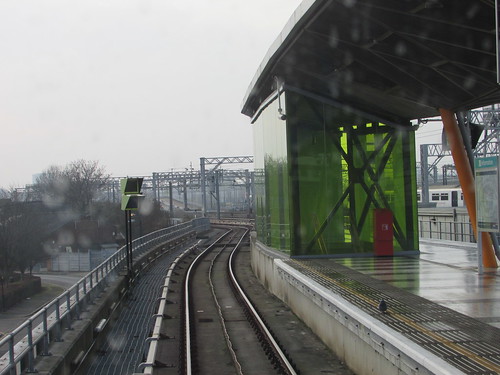
View from front of DLR train leaving Stratford platform 4A.
The line singles leaving Stratford, squeezed into a narrow margin on the south side of the former Great Eastern main lines. Next, the line doubles and slews to the left through Pudding Mill Lane station before turning right, reverting to the original alignment of a single line next to the main lines. Apparently, this (fairly recent) alteration was to accommodate Crossrail works in the vicinity of the original station - Pudding Mill Lane now has quite a grand new station.
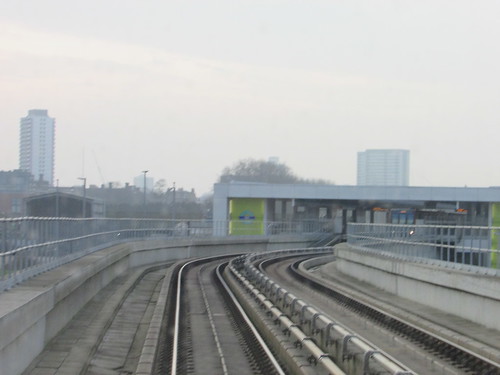
The single line doubles through the new Pudding Mill Lane station.
After continuing parallel to the Liverpool Street lines past the former Bryant & May factory, the line turns south and becomes double track before Bow Church station.
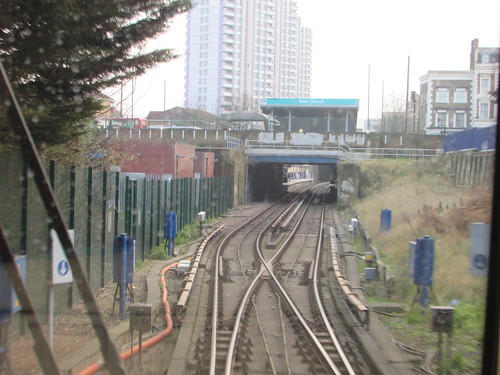
The single line doubles before Bow Church station.
Our route continued through Devons Road, Langdon Park and All Saints. Beyond All Saints stations, connections diverge to the right to serve the sidings at the depot at Poplar. Approaching Poplar station, the route from Canning Town converges.

Docklands Light Railway: Turnouts approaching Poplar station.(L-R): WB Canning Town, SB Stratford, NB Stratford, EB Canning Town (on flyover).
Leaving Poplar station, my train swung sharply left as it climbed the steep East Curve to West India Quay. Just 200 metres further on, we stopped under the elliptical, glazed roof of Canary Wharf Station, where I changed trains. The three roads through the station are provided with two island platforms and two flanking platforms so each road has a platform on both sides to improve passenger flow. I alighted on the correct side and, within a minute or two, my connecting train arrived on the opposite face of the same platform.
 Docklands Light Railway: Changing trains at Canary Wharf.
Docklands Light Railway: Changing trains at Canary Wharf.
The train I'd joined was heavily loaded for our journey through Heron Quays, South Quay, Crossharbour (with its turnback siding) and Mudchute (now with a third, terminal platform). Originally, the double track beyond Mudchute ran on the surface to a simple terminal at Island Gardens. Now the line is extended to Lewisham, the line dives underground to a new underground station at Island Gardens after which it crosses the Thames to a second underground station called Cutty Sark, where I disembarked, along with a crowd of other passengers. The train I'd left would continue to stations at Greenwich, Deptford Bridge, Elverson Road and Lewisham. I reached the surface quite near the river and the impressive bulk of Cutty Sark, now transformed into a major tourist attraction.
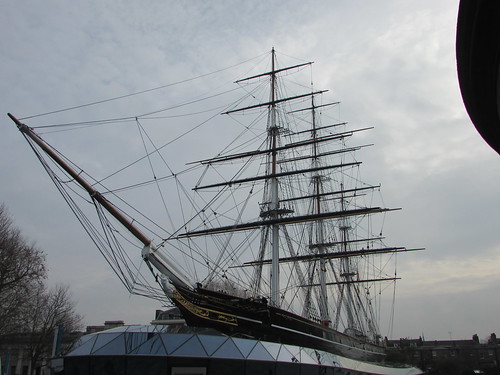
London, Greenwich: Cutty Sark.
I was tempted to go back to Island Gardens through the Greenwich foot tunnel which, since the last time I used it, now has user-operated lifts. However, unsure of the time this detour would take, instead I took a few photographs around what is now Maritime Greenwich World Heritage Site.
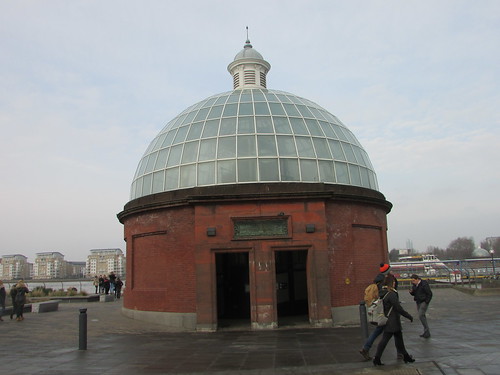
London: Entrance to Greenwich Foot Tunnel
Near the river, there were splendid views of the incomparable 17th-century buildings designed by Sir Christopher Wren (on the site of the earlier Royal palace) built as the Royal Hospital for Seamen, housing retired veterans of Britain's navy, later seeing service as the Royal Naval College. The Old Royal Naval College has a website here.
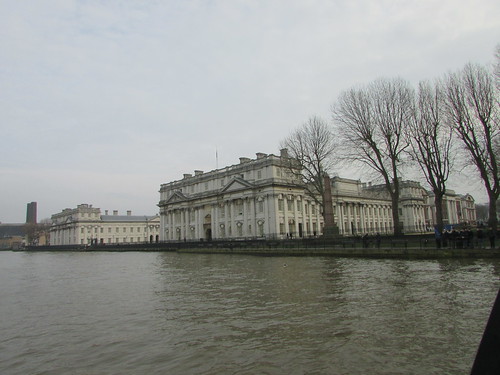
London: The Old Royal Naval College, Greenwich:
After admiring Wren's creation, my eye was also drawn downstream to the rather grim outline of Greenwich Power Station, with its four 8-sided chimneys and, thrust into the Thames, its disused coal unloading jetty standing on sixteen massive cast-iron Doric columns.
Greenwich Power Station
In the post London Underground - Traction Power Distribution, I mentioned the importance of London Underground's Greenwich Power Station. Since Lots Road Power Station was shut in 1998, London Underground has derived its power from the National Grid, but Greenwich was retained as the Central Emergency Power Supply.
Greenwich Power Station was built in two stages between 1902 and 1910 for the London County Council to power trams and underground trains. There are articles on the origins of Greenwich Power Station in Grace's Guide here and in Port Cities here. There's also a brief account in Wikipedia here.
I was surprised to discover that tables showing the generated output from the power station for the ten years to 2014 are available online (following a Freedom of Information Request) here. This is available through the mySociety project of the charity UK Citizens Online Democracy (UKCOD).
A plan to improve efficiency and lower the carbon footprint of the station using a new Combined Heat and Power (CHP) gas installation is under consultation.

London: Greenwich Power Station.
Ferry to London Bridge
I'd decided to take a ferry from Greenwich to London Bridge City pier, near the location of my meeting. MBNA Thames Clippers operate a scheduled service of fast ferries on the river. Their web site is here and details of their fleet of modern, large catamarans powered by waterjet or propellor are here. The huge 220-seat 'Hurricane Clipper' arrived on time and, within moments, was loaded and heading upstream again.
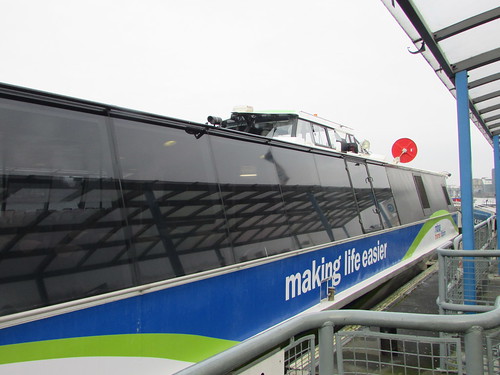
London: 'Hurricane Clipper' at Greenwich landing stage.
After a brief pause at Canary Wharf we continued upstream, passed through the north fixed span of Tower Bridge and then set off again, passing the moored light cruiser 'H.M.S. Belfast' (there's a post describing a visit I made here) and stopping at London Bridge City Pier after a total journey time of just over 20 minutes. I disembarked with a few other passengers and 'Hurricane Clipper' roared away upstream.
After an informative and enjoyable few hours, I made my way to my meeting.
My Pictures
Where necessary, clicking on an image above will display an 'uncropped' view or, alternately, pictures from may be selected, viewed or downloaded, in various sizes, from the albums listed:-
London: Former Great Eastern Line.
Docklands Light Railway.
London, England.
